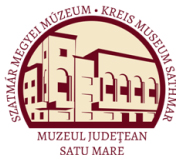Marta, Liviu: The Late Bronze Age Settlements of Petea-Csengersima (Satu Mare, 2009)
VI. Annexes
S14 Complex 4 (Fig. 11, 12) — A pit had irregular contour but round margins (120 x 126 cm). It occurred in the sterile soil. The walls went steep or steeply inclined 65 cm towards the flat base. The fill was dark grey, like the cultural layer. S14 Complex 5 (Fig. 11, 12) — A pit had irregular oval outline (195 x 250 cm). A step took shape at 20 cm in depth, in the southern side of the pit. Further deep, the walls were steep, or steeply inclined, or arched towards the inside for 56 cm to the flat base, which was superimposed by a 25-32 cm thick layer of ceramic shards, grinder fragments and weights of fired clay. A bronze needle was found in the objects deposition. Some of the vessel fragments were re-fired, but others were not fired at all, even if they were part of the same vessels. It turned out that several shards of the 4 vessels were laid grouped. The fill of the pit was grey and contained many traces of charcoal and a few small fired bones among the objects laid on the pit base. Inventory: 1) 23 ceramic shards, of which 20 were re-fired, restored a half of an amphora; the body was refired. (PI. 16/2) 2) 36 fragments (31 were re-assembled), of which 31 were re-fired (some of them were vitrified) and restored the most part of an amphora. (PI. 17/1) 3) 54 ceramic shards (42 were re-assembled), of which 24 were re-fired and restored a part of an amphora. The rim, the neck and the body contained re-fired shards as well as not-fired fragments, indicating that the first shards had been fired after the vessel was broken. (PI. 17/4) 4) 23 ceramic shards (19 were re-assembled) were re-fired. They were part of the neck and body of a small amphora. It's possible that 6 pottery fragments that were hard re-fired restored a part of the lip and neck of the same vessel. (PI. 18.1) 5) 15 ceramic shards (4 were re-fired) of a small amphora decorated with oblique ribs and bosses (PI. 18/2). 6) 22 fragments (12 were assembled), 6 of which were re-fired, restored more than 2/3 of the neck and body of a small amphora (PI. 18/3). 7) 25 fragments, 10 of which were re-fired, restored approximately 10—12% of the inferior part and shoulder of an amphora with shiny-black outside and brown-yellowish on the inside (PI. 18/10) 8) 46 ceramic shards originated from a conical vessel with black outside and brick red coloured inside. More than half of the mouth was preserved, as well as several shards from the body and base. The shards lack in decorations, thus they could be attested only according to their inside and outside colour as well as according to the texture of the paste. In this case, it was difficult to establish if some re-fired fragments belonged to this vessel. 9) 27 pottery fragments (re-fired) from the upper side of a portable cooking vessel. The fragments it comprised were differently fired, indicating this process took place after it had been broken into pieces. It's difficult to establish if one of the vessel bases from the pit was its, but the colour and texture of one of the bases seemed to be similar with the vessel's (PI. 20/2). 10) 15 fragments (13 were re-fired) from the upper part and from the legs of a portable cooking vessel. The upper part of the portable cooking vessel was hard re-fired to distortion. One of the shards of the feet was not fired, but the other one was (PI. 19/7). Some scattered fragments could be assigned to the vessel, according to colour, thickness and paste texture, some of them being re-fired. In the same context, one of the vessel bases, seemed to belong to it (PI. 19/8). 11) 66 fragments (45 re-assembled, 28 re-fired) from a large-sized vessel had thick walls made of coarse paste — it was probably a storage v.essel. Three of the fragments from the upper side of the body were hard re-fired. Among other few fragments that were partially fired, there were some parts of the vessel that were fired after breakage. It's possible that 20 more fragments that were re-fired belonged to this vessel because they corresponded in thickness, composition and intensity in firing. The thicker and stronger fired fragments of the pit walls SI4 Complex 3 - Roman Age dwelling 117
